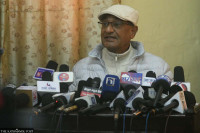National
Gender-responsive budgeting: Good on paper, poor on implementation
In the absence of monitoring and evaluation mechanisms, existing gender financing policies of Nepal have failed to yield desired results.
Aakriti Ghimire
Nepal is one of the countries that made relatively large leaps in a range of gender equality issues between 2015 and 2020, according to the 2022 Sustainable Development Goals Gender Index.
Nepal made a progress of 6.7 points, from 58 in 2015 to 64 in 2020, by making strides on five frontiers—women’s land rights, women in parliament, access to sanitation, laws on workplace equality and transparent national budgets.
The adoption of gender-responsive budgeting (GRB) that aims to mainstream gender into macro-economic policy and the national budgeting system has played a crucial role in making the government accountable for its commitment to gender equality and women’s empowerment.
“One of the policies under GRB for the corporate sector is if a company has more than 33 percent female employees, the company gets a 20 percent tax rebate. In addition, the company also gets a 10 percent corporate social security, which is tax-free money,” says Nigma Tamrakar, a gender-responsive budgeting expert, previously stationed at the Ministry of Finance through the UN Women. “Likewise, there are policies where if a company—private, micro, cottage industry—is registered under women’s names, there are tax exemptions. Similar to land policies. Now, not all women might be decision-makers despite that, but it played a crucial role in bringing women on a level financial playing field.”
Nepal might have made great strides in introducing and adopting various policies that aim to address gender inequality, but experts say those policies are insufficient. In addition, the lack of monitoring and evaluation mechanisms has created major barriers to implementing the existing policies.
“Firstly, the policies themselves are insufficient,” says Sulochana Khanal, programme coordinator at WOREC (Women’s Rehabilitation Center). “In light of increased reporting of gender-based violence cases, the focus is still only on making safe houses. In addition, there are no specific details of any programmes.”
Khanal has a host of questions: “How will they ensure social reintegration of female migrant workers who have returned from abroad? How will they ensure healthcare and psychological wellbeing of conflict-related victims of violence? And how will they even evaluate the effectiveness of the policies they have introduced?”
Nepal first adopted GRB in the fiscal year 2007-08 to fulfil its constitutional requirement and international commitments to gender equality—as a signatory of the Convention on the Elimination of All Forms of Discrimination against Women (CEDAW), the Beijing Platform for Action (BPFA), Millennium Development Goals (MDGs), and Sustainable Development Goals (SDGs).
The public budgetary expenditure is classified annually under three sections—directly responsive to gender, indirectly responsive, and neutral across all sectors.
If more than 50 percent of the budget directly benefits women, it is classified as directly responsive; if 20 to 50 percent of the budget benefits women, then it is considered indirectly responsive; and budget allocations that benefit women less than 20 percent are considered neutral.
In the last 15 years, there has been an almost four-fold rise in direct gender-responsive budgeting, from 11.03 percent in 2007-08 to 40.25 percent in 2022-23.
Similarly, there has been indirect gender-responsive budgeting, rising year-on-year, reaching over 48 percent of the total budget in 2016-17.
For the next fiscal year, indirect gender-responsive budgeting stands at 34.95 percent.
Policies such as reduction in land registration fees for properties under women’s ownership, quota system in the parliament, police and army, increased availability and incentives for maternal health services, safe houses for victims of domestic violence and human trafficking, compulsory toilets in schools for girls and scholarships to incentivise female education and women-friendly taxation policies have been introduced over the years under GRB.
Research finds that such GRB policies have led to an increased land ownership of women, increased women’s participation in the labour force—as teachers in government schools, parliamentarians, police officials, as workers in departmental stores, women entrepreneurs as micro and small scale business owners and so on.
In addition, the maternal mortality rate is also on a declining trend.
The fiscal budget 2022-23 has introduced various policies under the subtitle “women, children and senior citizens.”
The budget outlines policies for continuing and bettering air rescue for pregnant women and new mothers in rural areas. Under the ‘Mahila Pahila’—or women first—programme, the government plans to build hostels for children who have to walk long distances to reach school and provide compensation and rehabilitation for women with autism, mental disability and spinal injury.
The government also plans to introduce ‘women’s cells’ in crowded places such as bus parks and airports, and continue safe houses for victims of domestic violence and gender-based violence and toll-free numbers for victims of violence at home and at workplace. Psychosocial counselling and employment opportunities for victims of conflict-era crimes are also included.
The budget also states that workplace discrimination and harassment will not be tolerated and the policy of equal pay for equal work should be implemented by ensuring the effectiveness of labour audit.
However, gender and economics experts are wary that GRB might not achieve its goals despite being great on paper.
They describe these policies as superficial and call it a ‘blanket approach’ that diverts from the core problem at hand.
“The policies are always focused on response, but not on preventing things… for example, cases of violence, or the need for helicopters for pregnant women. Our focus should be on ensuring that there shall be no victims of violence at all, or that everyone has access to timely healthcare. And this starts with budgeting,” says Khanal. “Instead of addressing the core problems of violence, they always focus on superficial approaches. They should have instead focused on having comprehensive sexuality education for children for long-term solutions.”
Despite a total of 75.2 percent of the national budget allocated as GRB, gender experts say that these programmes might not come to fruition, given the failure to implement such policies in the past.
On one hand, the policies are insufficient and on the other, the existing policies are not implemented, they say.
“Why have we not been able to ensure safety from workplace harassment so far?” asks Tamrakar, a gender and economics expert. “There is neither a reporting system nor a code of conduct that has been outlined. There are no specific details on how these policies will be implemented.”
Experts say that in the past fiscal years, under various training programmes for women, many women were given two-day training on making bride’s shoes or making paper flowers as decorative items. These trainings were largely performative and insubstantial, they say.
Experts also highlight that under the budget for agriculture, which promises seed banks, tools and technologies, women’s needs were largely ignored.
“The government said it would distribute hand-tractors to farmers. Great. But women and poor farmers in Shantinagar and Dangisharan villages in Dang could never make use of that,” says Kanchan Lama, principal investigator of a project on economic empowerment of women at ForestAction Nepal, a forestry research organisation.
Among the total employed population in Nepal (7.1 million), 84.6 percent, or 6 million, engage in informal work. And 90.5 percent of women workers in Nepal engage in informal employment.
In the agriculture sector, which is the most informalised sector in the country (97 percent of agricultural workers are engaged informally), women workers occupy the majority of informal employment. But their needs aren’t addressed in this budget either, according to experts.
“Women need tools that help them weed better. They need small, handy tech. They would benefit from alternative energy resources and easier accessibility of fertilisers and seeds. The seeds given by the government don't even grow,” says Lama. “Local women in villages often say ‘this isn’t for women, this is only for the rich.’”
Referring to usages of budget in previous fiscal year, gender and economics experts say that the budget gravely failed in implementation.
In the last fiscal year, around 4 percent of the budget allocated for Province 1 was supposed to be directly invested for women. But only 1.18 percent was actually implemented in a gender-responsive fashion, says Tamrakar.
According to a policy review, despite mandated GRB policies at provincial and local level governments, projects often are not gender-responsive and fail to address issues of inequity, intersectionality and diversity of women across caste, class, religion, and sexuality divides.
The Ministry of Women, Children and Senior Citizens has received 0.10 percent of the total budget of 1.79 trillion for the fiscal year 2022-23.
Further disaggregated budget finds that only 0.03 percent of the total budget is dedicated to Goal 5, gender equality, under Nepal’s commitment to achieving Sustainable Development Goals by 2030.
Given the worrisome trends of implementation of GRB, experts are concerned that the values of GRB will not materialise in the lack of active monitoring mechanisms from civic societies and local non-governmental organisations (NGOs).
“Safe houses for women operate really well in areas where there are NGOs fighting for women’s rights. That’s why monitoring the budget expenditure by civic societies, local NGOs, women’s rights groups, and independent committees is extremely crucial,” says Lama, the gender, equity and social inclusion expert. “Video monitoring and regular auditing by regional NGOs could also be done.”




 9.12°C Kathmandu
9.12°C Kathmandu













%20(1).jpg&w=300&height=200)

